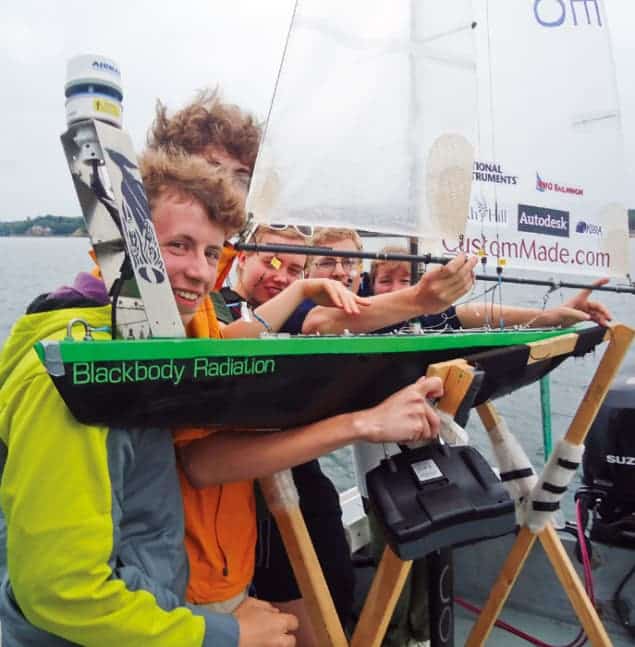Can advanced physics be taught in a project-based curriculum? Robert P Crease drops in at an innovative, new US engineering college to find out

“Our project concerned optimizing a manual longboard stand-up slide,” said Myles Cooper as he stood on a skateboard at the front of the class, holding an unattached skateboard wheel in his hands. It was the last day of “Advanced Classical Mechanics” (ACM), a course at Olin College in Massachusetts. Myles and two other first-year students, including my son Alex, were presenting their final project.
For non-skateboarders, Myles explained that a “longboard” is an elongated skateboard used for downhill cruising and tricks, “manual” means riding on the two back wheels only and “stand-up slide” means skidding, usually downhill. Longboarders consider slides to be awesome and have “slide jams” (see YouTube) to see who can achieve the longest slide without the wheels spinning. The group’s project was to use the tools of classical mechanics to find a function to optimize the distance that a rider could slide downhill on two wheels.
Was this an awesome diversion or effective pedagogy? I had come to Olin College to find out.
Exciting experiment
The college was conceived of in the 1990s as an ambitious response to repair the dismal state of US undergraduate engineering education. At that time, first-year engineering students came in passionate about their calling but half wound up ultimately changing their degree and a fifth dropped out of college entirely. The problem appeared to be an overemphasis on theory; imagine a music school that forced performance students to take three years of theory and harmony before touching an instrument.
In 1997 the F W Olin Foundation, set up in 1938 by the engineer-turned-businessman Franklin Olin, provided an initial $200m to create a new engineering college to foster students’ passion from day one. Most classes are organized around team projects. Olin’s founders call it “just-in-time” education – giving students the knowledge required to complete a project – versus “just-in-case” education, or loading students with knowledge for its own sake. The college is small, with about 350 students and nearly half of them female. The result is, in my view, the most exciting educational experiment in recent history.
As a parent of one of these students, am I biased? Totally. So don’t trust me, check the statistics. Some 98% of all Olin graduates get jobs or go to graduate school. More than 200 engineering programmes elsewhere have sent representatives to Olin to study the curriculum. Earlier this year three Olin founders, including the current president, Richard Miller, won a National Academy of Engineering prize for their efforts.
Though entranced by the educational concept, I was sceptical that physics could be taught effectively in the same project-based way as engineering. The ACM professor, Yevgeniya Zastavker, who has a PhD from the Massachusetts Institute of Technology, explained that ACM is less project-based than most courses at Olin College. Students do projects only at the end, although this work is integral to their education, providing them with hands-on application of physics to engineering contexts. She invited me to observe.
Complex affair
This is what Alex posted on Facebook the night before the presentation: “After spending 16 hours working in the same room save food breaks, spending two weeks figuring out how to model a two-wheeled longboard stand-up slide, running an extremely ridiculous set of differential equations for five days with no result, and possibly learning more about the physics of longboarding than probably any person ever, I AM FINALLY DONE WITH MY ACM FINAL PROJECT!”
A few hours after this post, the group members presented their work in class. They based their initial model on mass, acceleration caused by gravity, hill slope, angle θ between the slope and direction of wheel roll (θ= 0 follows the slope), and coefficients of static and kinetic friction. They created functions describing the system using these parameters for a given slope and θ, using MATLAB to plot these parameters. They found, for instance, that the longest slide with a slope of 15°, an initial velocity of 8 m/s and a constant θ occurred when θ was roughly 63°.
To maximize the slide path, however, requires constantly changing the value of θ. To analyse this further, the group first studied the energetics of the situation, using the Lagrangian approach to make three second-order differential equations for the relations of the system’s components in the x, y and z axes. They ran this through Maple (more powerful than MATLAB) but the presence of too many recursive functions made it impossible to solve. With their presentation looming they returned to a Newtonian approach in terms of forces, writing a MATLAB program that used equations from their first attempt but for which they had to keep resetting θ by hand. What seemed to be a simple system, in short, required complex analytic methods.
The same was true for the other groups that day. One modelled the forces on the college’s robotic sailboat. Another tried to model Spider-man’s iconic movement down a street by shooting silk strands at building walls – a series of spherical spring-pendulum motions in which he never hits the ground or walls. “It looks like a simple system to describe mathematically,” said Abe, a first-year student, “but it turns out that there’s not really an analytical solution and the system quickly becomes chaotic.”
The critical point
I came away convinced that much of classical mechanics can, indeed, be taught via the rigorous analysis of real-world situations “just in time”.
But not everyone appreciated the students’ work. The following complaint appeared on a Web forum on which Olin students had discussed skateboarding physics: “Why are you all trying to put square science into my fun hippie longboarding?” The students’ sarcastic response: “Don’t worry, we modelled the final trajectory with a quartic function, not a ‘square’ one!”



